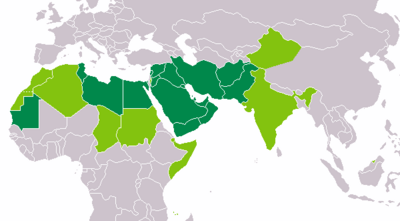Arabic alphabet facts for kids
| Use of the Arabic alphabet in the world | |
|---|---|
| → Countries where the Arabic script is the only script used officially | |
| → Countries where the Arabic script is used with other scripts | |
Quick facts for kids Arabic abjad |
|
|---|---|
 |
|
| Type | Abjad |
| Spoken languages | Arabic, Persian, Baloch, Urdu, Kurdish, Pashto, Sindhi, Malay and others |
| Time period | 400 CE to the present |
| Parent systems |
Proto-Canaanite
|
| Unicode range | U+0600 to U+06FF U+0750 to U+077F |
| ISO 15924 | Arab (#160) |
| Note: This page may contain IPA phonetic symbols in Unicode. | |
The Arabic alphabet is a special kind of writing system called an abjad. It is used to write many languages, especially in the Middle East. Some of these languages include Arabic, Persian, Pashto, and Urdu. This alphabet is the third most used writing system in the world. Only the Latin alphabet (which English uses) and Chinese characters are used more.
Contents
What is the Arabic Alphabet Like?
The Arabic alphabet is written from right to left. This is different from English, which is written from left to right. When used for the Arabic language, it has 28 different letters.
Consonants and Vowels
In an abjad, mostly consonants are written down. Vowels are usually not written. This means you mostly see the consonant sounds.
Cursive Style
The Arabic script is a cursive writing system. This means that the letters in a word are connected to each other. This happens both when you write by hand and when you see it printed. Each letter can look a bit different depending on where it is in a word. For example, a letter might look one way at the start of a word, another way in the middle, and a third way at the end. There are no separate forms for uppercase or lowercase letters, like in English.
Main Styles of Arabic Script
There are two main modern styles of the Arabic alphabet.
- Naskh is the style you usually see in printed books and newspapers.
- Kufic is another common style. It was named after the city of Kufa in Iraq, where it was developed. You might see Kufic used for decoration or in older texts.
Numbers in Arabic Script
In the past, especially during the Middle Ages, the Arabic alphabet was also used to write numbers. Today, we mostly use the numbers you are familiar with (like 1, 2, 3), which are sometimes called "Arabic numerals" but actually came from India.
When the Arabic alphabet was used for numbers, each letter had a number value. For example, the letter alif was 1, bāʼ was 2, and so on. This system was sometimes used to create chronograms. A chronogram is a phrase or sentence where certain letters, when added up by their number values, give a specific date. It's like a secret code for dates!
How Letters Are Ordered
When you look up words in a dictionary, the letters need to be in a specific order. The Arabic alphabet has two main ways to sort its letters:
- Abjad order: This order comes from the very old Phoenician alphabet.
- Hijāʼ order: This order groups letters by how similar they look. This is the more common way to sort letters today.
A Journey Through Time: History of the Arabic Alphabet
The Arabic alphabet spread widely as the religion of Islam grew across the Middle East, North Africa, and Asia. Muslims believe that the angel Gabriel spoke Allah's words to Muhammad in Arabic. Because of this, learning Arabic is important for Muslim rituals like prayer and reading the Quran. As Arabic spread, its writing system also spread. For example, it replaced the Pahlavi writing system in Persia when Islam arrived there.
Another alphabet, the Uighur alphabet, was created based on the shapes of Arabic letters. However, the Uighur alphabet always writes out its vowel sounds, which is different from Arabic.
Changes in the 20th Century
After the First World War, the Ottoman Empire fell. This led to some changes in how the Arabic language and alphabet were used in Muslim countries.
- In 1928, Turkey made a law that stopped using the Arabic alphabet for writing Turkish. Turkish is now written using the Latin alphabet, just like English.
- The Soviet Union also influenced countries in Central Asia, like Azerbaijan, Kazakhstan, and Uzbekistan. They first tried to make these countries use the Latin alphabet. This was to reduce religious influence and to modernize the region. Later, the Soviet Union made them switch to the Cyrillic script (like Russian). This was to make their cultures more like Russia's.
Even after the Soviet Union ended, most of these Central Asian nations did not go back to using the Arabic alphabet. Some still use Cyrillic, while others adopted new Latin alphabets. Only Tajikistan is thinking about switching back to the Arabic alphabet.
Arabic Script in Southeast Asia
In Southeast Asia, countries like Malaysia, Indonesia, Singapore, and Brunei mostly use the Latin alphabet for the Malay language. This Latin alphabet is called Rumi in Malay. The British and Dutch colonial powers introduced it.
The Arabic alphabet, called Jawi in Malay, is still used in Malaysia, but less often than Rumi. Brunei is special because it is the only country in Southeast Asia where both the Latin and Arabic alphabets are officially used.
Related pages
Images for kids
See also
 In Spanish: Alfabeto árabe para niños
In Spanish: Alfabeto árabe para niños



